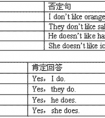句型转换。按要求完成下列句子,每空一词。1. It is necessary to do eye exercises between classes. (改为同义句) _____ eye exercises between classes _____necessary-八年级英语
I asked if he would come and repair my television set.我问他是否来修我的电视机
2) 情态助动词在限定动词词组总是位居第一:
They need not have been punished so severely.
3) 情态助动词用于第三人称单数现在时的时候,没有词形变化,即其词尾无-s形式:
She dare not say what she thinks.
4) 情态动词没有非限定形式,即没有不定式和分词形式,也没有相应的动名词:
Still,she needn't have run away.
5)情态助动词的“时”的形式并不是时间区别的主要标志。在不少场合,情态助动词的现在时和过去时形式都可以表示现在、过去或将来时间:
Would you mind very much if I ask you to do something?
She told him he ought not to have done it.
6) 情态助动词之间是相互排斥的,即在一个限定动词词组中只能出现一个情态助动词,但有时却可以与have和be基本助动词连用:
You should have washed the wound.
Well,you shouldn't be reading a novel.
7)情态动词must一般疑问句否定回答用needn't
Must I read books every day、
No,you needn't
常见情态动词用法:
1.can (could) 表示说话人能,可以,同意,准许,以及客观条件许可,could 为 can 的过去式。
2.Must 必须,应该,一定,准是,表示说话人认为有必要做某事,命令,要求别人做某事以及对事物的推测。
must 用来指一般现在时和一般将来时, 过去式可用 have to 的过去式代替。
must + have + 过去分词,表示现在对过去事物的推测。
must 和 have to 的区别:must 表示说话人的主观思想,have to 表示客观需要。
3.need 是一个情态动词,他的用法完全和其他情态动词一样,但 need 还可当作实义动词使用,这时 need 就象其他动词一样,有第三人称,单复数, 后面加带 to 的动词等特性。
needn't + have + 过去分词 表示过去做了没必要做的事情。
4.dare 除用作情态动词外,更多的是当实义动词使用, 用法同实义动词一样,要考虑人称,单复数,时态等。
5.ought 应当,应该。后面跟带有 to 的动词不定式。
ought + to have done 句型。指过去动作,表示一件事情该做而未做。
ought not to have done 句型。表示一件不该做的事情却做了。
6.will (would)决心,愿望。 would 为 will 的过去式,
will, would用于疑问句表示说话人向对方提出请求或询问,用 would 比 will 更婉转,客气。
7.Shall、should 表示命令,警告,允诺,征求,劝告,建议,惊奇。
8.have to,不得不,必须,表示客观条件只能如此,而must 则表示主观思想。
助动词主要有两类:基本助动词和情态助动词。
基本助动词有三个:do,have和be;
情态助动词基本的有十四个:may, might; can, could; will, would; shall, should; must, need, dare, used to, ought to.had better 上述两类助动词的共同特征是,在协助主动词构成限定动词词组时,具有作用词的功能:
1) 构成否定式:
He didn't go and neither did she.
The meeting might not start until 5 o'clock.
2) 构成疑问式或附加疑问式:
Must you leave right now?
You have been learning French for 5 years, haven't you?
3) 构成修辞倒装:
Nowhere can he obtain any information about his sister.
Hardly had he arrived when she started complaining.
4) 代替限定动词词组:
A: Who can solve this crossword puzzle?
B: Tom can.
A: Shall I write to him?
B: Yes, do.
情态动词表推测的用法小结
(一)情态动词表推测的三种句式
1.在肯定句中一般用must (一定),may(可能),might /can, could(也许,或许)。
(1)He must/may/might know the answer to this question?
他一定/可能/也许知道这个问题的答案。
(2)It is cold in the room. They must have turned off the heating.
屋里很冷,他们肯定把暖气关了。
2. 否定句中用can’t / couldn’t(不可能), may not/might not (可能不)。
(1)It can’t/couldn’t be the headmaster. He has gone to America. 这不可能是校长,他去美国了。
(2)He may not/might not know the scientist. 他也许不认识那位科学家。
3. 疑问句中用can/could (能……?)。
(1)Could he have finished the task? 他可能把任务完成了吗?
(2)Can he be at home now? 他现在能在家吗?
注:以上三种句式中情态动词的语气按程度都是依次递减的。Might, could并非may, can的过去式,而表示语气较为委婉或可能性较小。
(二)情态动词表推测的三种时态
1. 对将来情况的推测,用“情态动词 + 动词原形”。
(1)She must / may / might / could arrive before 5. 5: 00 前她一定/可能/也许到。
(2)She must/may/might/could walk miles and miles among the hills without meeting anyone.
她一定/可能/也许会在山里一连走好几英里而遇不到一个人。
2. 对现在或一般情况的推测,用“情态动词 + be”,“情态动词 +be doing”或 “情态动词 + 动词原形”。
(1)He must / may / might / could be listening to the radio now. 他一定/可能/也许正在听收音机。
(2)He can’t ( couldn’t ) / may ( might ) not be at home at this time. 这个时候他不可能/可能不在家。
(3)Mr. Bush is on time for everything .How can ( could ) he be late for the opening ceremony ?
布什先生一向准时,这次开幕式他怎么可能迟到呢?
3.对过去情况的推测,用“情态动词 + have +过去分词”。
(1)It must / may / might / could have rained last night .The ground is wet. 地湿了,昨晚肯定/可能/也许下雨了。
(2)The door was locked. He can ( could ) not / may ( might ) not have been at home . 门锁着,他不可能/可能不在家。
(3)Can / Could he have gotten the book? 难道他找到书了吗?
注:情态动词 should /ought to表推测时,意为“想必会,理应……”但与“have +过去 分词”连用时,则又可构成虚拟语气意为“本应该做某事却没做”。
例如:
(4)It’s seven o’clock. Jack should/ought to be here at any moment.
现在七点钟了,杰克理应随时到达。(推测)
(5)She should / ought to have attended your birthday party, but she had to look after her mother in hospital. (虚拟)
她本该出席你的生日晚会的,可是她得在医院照顾她妈妈。
(6)Tom should not /ought not to have told me your secret, but he meant no harm. (虚拟)
汤姆本不该告诉我你的秘密,可是他并无恶意。
考点名称:并列连词
- 并列连词:
主要是用来表示并列关系、选择关系、因果推理关系等。也可用来连接平行的词,词组或分句。 并列连词表示关系及代表实例:
1.表示并列关系
表示并列关系的连词主要含有“和”、“补充”、“增加”等意思。用来表达并列关系的连词有如下几个:
and 和 both...and...二者都
either...or...或者...或者...
neither...nor...既不...也不...
as well as 也、连同
not only...but (also)... 不但...而且...
e.g.
I used to live in Paris and London.
我过去住在伦敦和巴黎。
Both Jane and Jim are interested in pop music.
詹妮和吉姆对流行音乐都很感兴趣。
She is not only kind but also honest.
她不但和蔼而且诚实。
Bob as well as his parents is going on holiday this summer.
鲍勃和他的父母今年夏天要去度假。
2.表示转折关系
常用来表示转折关系的并列连词有如下几个:
but 但是
yet 然而
still 仍然
while 然而
while 然而、偏偏
e.g.
The winter in Beijing is very cold while that of Kunming is warm.
北京的冬天很冷,然而昆明的冬天却很温暖。
I explained twice, still he counldn't understand.
我解释了两遍,然而他却还不懂。
3.表示选择关系
表示选择关系的并列连词:
or 或者
or else 否则
otherwise 否则
neither...nor... 既不...也不...
either...or... 或者...或者...
e.g.
Would you like leave or would you like to stay?
你是想走还是想留?
You can come either on Saturday or on Sunday.
你可以星期六来也可以星期天来。
Neither you nor I nor anyone else believes such things.
不管你我或者其他任何人都不会相信这件事。
- 最新内容
- 相关内容
- 网友推荐
- 图文推荐
| [家长教育] 孩子为什么会和父母感情疏离? (2019-07-14) |
| [教师分享] 给远方姐姐的一封信 (2018-11-07) |
| [教师分享] 伸缩门 (2018-11-07) |
| [教师分享] 回家乡 (2018-11-07) |
| [教师分享] 是风味也是人间 (2018-11-07) |
| [教师分享] 一句格言的启示 (2018-11-07) |
| [教师分享] 无规矩不成方圆 (2018-11-07) |
| [教师分享] 第十届全国教育名家论坛有感(二) (2018-11-07) |
| [教师分享] 贪玩的小狗 (2018-11-07) |
| [教师分享] 未命名文章 (2018-11-07) |

![Which of the following can you probably see in the meeting room? [ ]A. B. C.D. -七年级英语](http://www.00-edu.com/d/file/ks/4/2/dongmingci/2020-01-08/small97361980a56115e1c9237567439904fe1578422951.jpg)

![—Can the boy finish_____ the book in about a week? —I think he can. [ ]A. read B. reading C. to read D. reads -八年级英语](http://www.00-edu.com/d/file/ks/4/2/dongmingci/2020-01-08/smallfa4d713075e249356362fe7392193a301578421751.png)


